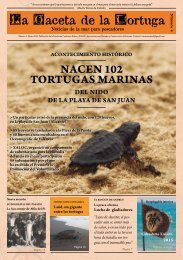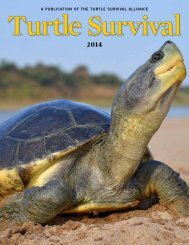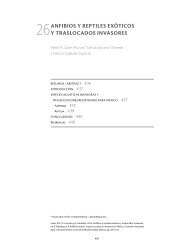tsrp63entire
tsrp63entire
tsrp63entire
You also want an ePaper? Increase the reach of your titles
YUMPU automatically turns print PDFs into web optimized ePapers that Google loves.
Objectives and actions<br />
Objective 14.1:<br />
Objective 14.2:<br />
To identify the key agents of decline for native frogs in New Zealand.<br />
To investigate the impact of habitat and pest management (e.g. use of toxins,<br />
modification of habitat, ecosystem restoration) on native frogs.<br />
Action Accountability Priority<br />
14.1 Determine the impacts of rats, mice and pigs on<br />
native frog populations by 2017.<br />
14.2 Complete the investigation into the effect<br />
of targeted rat control on the Archey’s frog<br />
population in Whareorino Forest, and analyse,<br />
interpret and distribute and/or publish the results<br />
by 2015.<br />
14.3 Test the susceptibility of all native frog species to<br />
infection by amphibian chytrid fungus by 2014.<br />
14.4 Assess the impact of kiwi on frog populations<br />
using experimental trials combined with a<br />
modelling approach by 2016.<br />
14.5 Determine baseline disease profiles for two<br />
populations of each species by 2016.<br />
14.6 Enter all records of dead frogs into the<br />
Huia database as they occur, throughout the<br />
term of this plan.<br />
14.7 Determine the effects of selected ecosystem<br />
restoration projects (e.g. predator exclusion<br />
and predator control) on native frogs using<br />
population monitoring by 2018.<br />
14.8 Assess the threat to frogs of toxins that are<br />
commonly used for pest and weed control<br />
in native frog habitat through post-mortem<br />
analyses and experimental trials by 2017.<br />
14.9 Assess the effects of land use activities<br />
(e.g. roading, subdivision, production forestry<br />
and mining) in native frog habitat on<br />
frog populations by 2018.<br />
14.10 Develop best practice guidelines for the use of<br />
toxins in native frog habitat by 2018.<br />
Recovery Group<br />
Science and Capability Group<br />
Relevant Conservation Services Group staff<br />
Recovery Group<br />
Science and Capability Group<br />
Relevant Conservation Services Group<br />
staff responsible for management of<br />
Whareorino Forest<br />
Recovery Group<br />
Recovery Group<br />
Kiwi Recovery Group<br />
Relevant Conservation Services Group<br />
staff responsible for management of the<br />
Marlborough Sounds islands<br />
Recovery Group<br />
Relevant Conservation Services Group staff<br />
Wildlife Health Coordinator<br />
Recovery Group<br />
Wildlife Health Coordinator<br />
Relevant Conservation Services Group staff<br />
Recovery Group<br />
Relevant Conservation Services Group staff<br />
Recovery Group<br />
Science and Capability Group<br />
Recovery Group<br />
Relevant Conservation Services Group staff<br />
Science and Capability Group<br />
Recovery Group<br />
Essential<br />
Essential<br />
Essential<br />
Essential<br />
High<br />
High<br />
High<br />
High<br />
High<br />
Medium<br />
28 Bishop et al.—Native frog recovery plan, 2013–2018





